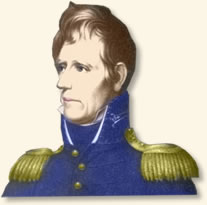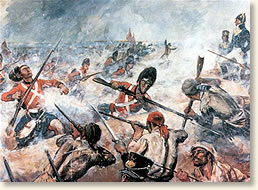|
The Battle of New Orleans, 1815
The American mission seemed hopeless. As dawn broke on the morning of January 8, 1815 a ragtag group of Americans faced off against the world's mightiest military force a few miles south of New Orleans. America was in bad shape: its treasury was almost bankrupt, its Capital had been ransacked the preceding summer (see "The British Burn Washington, 1814") and public support for the war was dwindling.
War between America and Britain had been raging since 1812, but it was only with the recent defeat of Napoleon that the British Empire could unleash the full force of its military might to squash its former colonies. British strategy focused on capturing the port of New Orleans. Its capture would give them control of the Mississippi River and sever America's vital commerce route to the Gulf of Mexico and beyond. The British began amassing its invasion force in the summer of 1814. Alerted, the US government dispatched a frantic message to General Andrew Jackson to immediately proceed to New Orleans and devise a defense of the city.
 |
Andrew Jackson
at the time of the battle |
Jackson arrived in the city on December 2, 1814 and found its citizens in near-panic. A British naval force appeared on near-by Lake Borgne on December 12 and quickly destroyed the American defenses there. By December 23 the British land force was only 8 miles south of the city. Jackson announced to the British that he was ready to fight by immediately launching an attack. Rebuffed, Jackson retreated only three miles towards the city where he ordered the digging of a watery trench bordered by a massive breastwork that stretched some 1000 yards from the swamps to the Mississippi River. Here, Jackson would make his stand.
The battle was joined during the early-morning hours of January 8, 1815. Poor leadership, confusion on the battlefield, the swampy terrain and American tenacity combined to create a debacle for the British Army. Within an hour after it started, the fight was ended with the surrender of the British on the battlefield. The British suffered an estimated 300 killed and 1,200 wounded while the Americans counted 13 killed and 52 wounded or missing.
In an ironic twist of history, peace between America and Britain had been achieved two weeks earlier with the signing of the Treaty of Ghent. However, news of the event had not reached the shores of America. Despite its lack of impact on the outcome of the war, the battle was an important milestone in America's development. The victory gave the American people pride in their new nation and confidence in its future.
An unknown eyewitness, fighting from the top of the breastworks defending New Orleans, describes the battle.
"Col. Smiley, from Bardstown, was the first one who gave us orders to fire from our part of the line; and then, I reckon, there was a pretty considerable noise... Directly after the firing began, Capt. Patterson, I think he was from Knox County, Kentucky, but an Irishman born, came running along. He jumped upon the brestwork (sic) and stooping a moment to look through the darkness as well as he could, he shouted with a broad North of Ireland brogue, 'shoot low, boys! shoot low! rake them - rake them! They're comin' on their all fours!'
...It was so dark that little could be seen, until just about the time the battle ceased. The morning had dawned to be sure, but the smoke was so thick that every thing seemed to be covered up in it. Our men did not seem to apprehend any danger, but would load and fire as fast as they could, talking, swearing, and joking all the time. All ranks and sections were soon broken up. After the first shot, everyone loaded and banged away on his own hook.
Henry Spillman did not load and fire quite so often as some of the rest, but every time he did fire he would go up to the brestwork, look over until he could see something to shoot at, and then take deliberate aim and crack away.
At one time I noticed, a little on our right, a curious kind of a chap named Ambrose Odd, one of Captain Higdon's company, and known among the men by the nickname of 'Sukey,' standing coolly on the top of the brestworks and peering into the darkness for something to shoot at. The balls were whistling around him and over our heads, as thick as hail, and Col. Slaughter coming along, ordered him to come down.
The Colonel told him there was policy in war, and that he was exposing himself too much. Sukey turned around, holding up the flap of his old broad brimmed hat with one hand, to see who was speaking to him, and replied: 'Oh! never mind Colonel - here's Sukey - I don't want to waste my powder, and I'd like to know how I can shoot until I see something?' Pretty soon after, Sukey got his eye on a red coat, and, no doubt, made a hole through it, for he took deliberate aim, fired and then coolly came down to load again.
 |
| The battle |
During the action, a number of the Tennessee men got mixed with ours. One of them was killed about five or six yards from where I stood. I did not know his name. A ball passed through his head and he fell against Ensign Weller...This was the only man killed near my station.
It was near the close of the firing....there was a white flag raised on the opposite side of the brestwork and the firing ceased. The white flag, before mentioned, was raised about ten or twelve feet from where I stood, close to the brestwork and a little to the right. It was a white handkerchief, or something of the kind, on a sword or stick. It was waved several times, and as soon as it was perceived, we ceased firing.
Just then the wind got up a little and blew the smoke off, so that we could see the field. It then appeared that the flag had been raised by a British Officer wearing epaulets. It was told he was a Major. He stepped over the brestwork and came into our lines. Among the Tennesseans who had got mixed with us during the fight, there was a little fellow whose name I do not know; but he was a cadaverous looking chap and went by that of Paleface.
As the British Officer came in, Paleface demanded his sword. He hesitated about giving it to him, probably thinking it was derogatory to his dignity, to surrender to a private all over begrimed with dust and powder and that some Officer should show him the courtesy to receive it.
Just at that moment, Co!. Smiley came up and cried, with a harsh oath, 'Give it up-give it up to him in a minute.' The British Officer quickly handed his weapon to Paleface, holding it in both hands and making a very polite bow. A good many others came in just about the same time.
...On the opposite side of the brestwork there was a ditch about ten feet wide, made by the excavation of the earth, of which the work was formed. In it, was about a foot or eighteen inches of water, and to make it the more difficult of passage, a quantity of thornbush had been cut and thrown into it. In this ditch a number of British soldiers were found at the close under the brestwork, as a shelter from our fire. These, of course, came in and surrendered.
When the smoke had cleared away and we could obtain a fair view of the field, it looked, at the first glance, like a sea of blood. It was not blood itself which gave it this appearance but the red coats in which the British soldiers were dressed. Straight out before our position, for about the width of space which we supposed had been occupied by the British column, the field was entirely covered with prostrate bodies. In some places they were laying in piles of several, one on the top of the other."
References:
This eyewitness account first appeared in The Louisiana Historical Quarterly, Vol. IX, No. 1, January 1926, republished in Angle, Paul, M., The American Reader (1958); Remini, Robert Vincent, The Battle of New Orleans (1999).
How To Cite This Article:
"The Battle of New Orleans, 1815," EyeWitness to History, eyewitnesstohistory.com (2006).
|






